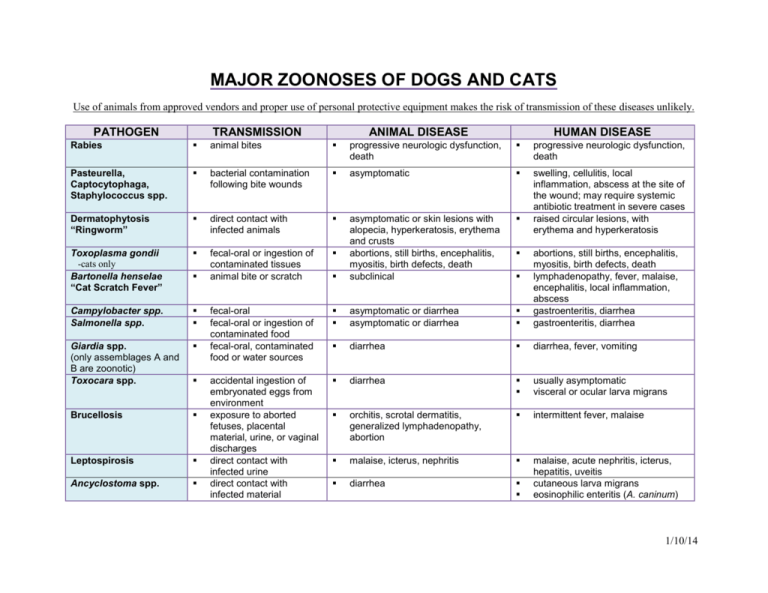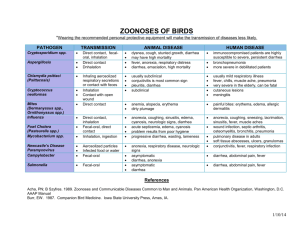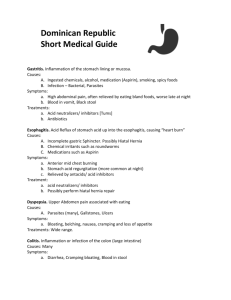MAJOR ZOONOSES OF DOGS AND CATS
advertisement

MAJOR ZOONOSES OF DOGS AND CATS Use of animals from approved vendors and proper use of personal protective equipment makes the risk of transmission of these diseases unlikely. PATHOGEN TRANSMISSION ANIMAL DISEASE HUMAN DISEASE Rabies animal bites progressive neurologic dysfunction, death progressive neurologic dysfunction, death Pasteurella, Captocytophaga, Staphylococcus spp. bacterial contamination following bite wounds asymptomatic Dermatophytosis “Ringworm” direct contact with infected animals Toxoplasma gondii -cats only Bartonella henselae “Cat Scratch Fever” fecal-oral or ingestion of contaminated tissues animal bite or scratch asymptomatic or skin lesions with alopecia, hyperkeratosis, erythema and crusts abortions, still births, encephalitis, myositis, birth defects, death subclinical swelling, cellulitis, local inflammation, abscess at the site of the wound; may require systemic antibiotic treatment in severe cases raised circular lesions, with erythema and hyperkeratosis Campylobacter spp. Salmonella spp. asymptomatic or diarrhea asymptomatic or diarrhea Giardia spp. (only assemblages A and B are zoonotic) Toxocara spp. fecal-oral fecal-oral or ingestion of contaminated food fecal-oral, contaminated food or water sources abortions, still births, encephalitis, myositis, birth defects, death lymphadenopathy, fever, malaise, encephalitis, local inflammation, abscess gastroenteritis, diarrhea gastroenteritis, diarrhea diarrhea diarrhea, fever, vomiting diarrhea usually asymptomatic visceral or ocular larva migrans Brucellosis orchitis, scrotal dermatitis, generalized lymphadenopathy, abortion intermittent fever, malaise Leptospirosis malaise, icterus, nephritis Ancyclostoma spp. accidental ingestion of embryonated eggs from environment exposure to aborted fetuses, placental material, urine, or vaginal discharges direct contact with infected urine direct contact with infected material diarrhea malaise, acute nephritis, icterus, hepatitis, uveitis cutaneous larva migrans eosinophilic enteritis (A. caninum) 1/10/14 EXTERNAL PARASITES External parasites of dogs and cats are capable of transmitting several diseases to humans. Dog sources, environmental conditions, and geographic location influence the incidence and risk associated with ectoparasites. Preventive measures should be designed to limit exposure and careful examination during quarantine is recommended to detect and eliminate external parasites. Below is a list of the most common ectoparasites and the zoonotic diseases they can transmit. PARASITE DISEASE HUMAN DISEASE Ticks Ehrlichia Lyme borreliosis Tularemia Rocky mountain spotted fever fever, headache, fatigue, and muscle aches fatigue, chills, fever, headache, rash, arthritis, neurologic signs fever, skin lesions, lymphadenopathy fever, headache, abdominal pain, vomiting, rash, muscle pain Fleas Bartonella Plague fever, lymphadenopathy, papules or pustules fever, chills, extreme weakness, abdominal pain, bleeding, shock Mites Scabies Cheyletiella pruritus, dermatitis erythematous macules or papules on the limbs and body ALLERGENS OF DOGS AND CATS Cats: Many people keep cats as pets. Therefore, sensitization can and does occur outside the laboratory environment. Furthermore, cat allergies may further predispose those affected to developing allergies to other lab animals. There is a close link between immunological sensitization and the development of asthma in people sensitive to these animals. The major cat allergen is the protein Fel d 1. It is produced by the sebaceous glands of the skin and coats the hair shafts. It is also produced in the saliva. Dogs: Like cats, sensitization to dogs may develop outside of the laboratory. The major dog allergen is Can f 1. Dog albumin has also been identified as another important allergen. Sources of exposure to dog allergens include saliva hair and skin. References 1. Greene, CE. 1998. Infectious diseases of the dogs and cats. WB Saunders, Philadelphia, PA. 2. Kirk, RW and JD Bonagura. 1992. Kirk’s Current Veterinary Therapy XI. W. B. Saunders, Philadelphia, PA. 3. Committee on Occupational Health and Safety in Research Animals Facilities, Institute of Laboratory Animal Resources, Commission of Life Sciences, National Research Council. 1997. Occupational Health and Safety in the Care and Use of Research Animals. National Academic Press, Washington, DC. 4. Ettinger, Feldman. 2010. Textbook of Veterinary Internal Medicine, Seventh Ed. Saunders Elsevier, St. Louis, MO. 1/10/14








